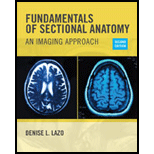
Fundamentals of Sectional Anatomy: An Imaging Approach
2nd Edition
ISBN: 9781133960867
Author: Denise L. Lazo
Publisher: Cengage Learning
expand_more
expand_more
format_list_bulleted
Question
Chapter 1, Problem 9RQ
Summary Introduction
Introduction:
Magnetic resonance imaging is a medical imaging technique used in radiology to form pictures of the anatomy and the physiological processes of the body. Computed tomography refers to a computerized X-ray imaging procedure where a narrow beam of X-rays is intended at a patient and quickly rotated around the body.
Expert Solution & Answer
Want to see the full answer?
Check out a sample textbook solution
Students have asked these similar questions
Amino
Acid Coclow
TABle
3'
Gly
Phe
Leu
(G)
(F) (L)
3-
Val
(V)
Arg (R)
Ser (S)
Ala
(A)
Lys (K)
CAG
G
Glu
Asp (E)
(D)
Ser
(S)
CCCAGUCAGUCAGUCAG
0204
C
U
A G
C
Asn
(N)
G
4
A
AGU
C
GU
(5)
AC
C
UGA
A
G5
C
CUGACUGACUGACUGAC
Thr
(T)
Met (M)
lle
£€
(1)
U
4
G
Tyr
Σε
(Y)
U
Cys (C)
C
A
G
Trp (W) 3'
U
C
A
Leu
בוט
His
Pro
(P)
££
(H)
Gin
(Q)
Arg
흐름
(R)
(L)
Start
Stop
8. Transcription and Translation Practice: (Video 10-1 and 10-2)
A. Below is the sense strand of a DNA gene. Using the sense strand, create the antisense
DNA strand and label the 5' and 3' ends.
B. Use the antisense strand that you create in part A as a template to create the mRNA
transcript of the gene and label the 5' and 3' ends.
C. Translate the mRNA you produced in part B into the polypeptide sequence making sure
to follow all the rules of translation.
5'-AGCATGACTAATAGTTGTTGAGCTGTC-3' (sense strand)
4
What is the structure and function of Eukaryotic cells, including their organelles? How are Eukaryotic cells different than Prokaryotic cells, in terms of evolution which form of the cell might have came first? How do Eukaryotic cells become malignant (cancerous)?
What are the roles of DNA and proteins inside of the cell? What are the building blocks or molecular components of the DNA and proteins? How are proteins produced within the cell? What connection is there between DNA, proteins, and the cell cycle? What is the relationship between DNA, proteins, and Cancer?
Chapter 1 Solutions
Fundamentals of Sectional Anatomy: An Imaging Approach
Ch. 1 - Match each of the following terms with the correct...Ch. 1 - Prob. 2RQCh. 1 - Match each of the following terms with the correct...Ch. 1 - Prob. 4RQCh. 1 - The plane running vertically or longitudinally...Ch. 1 - Identify the physical structure acting as a...Ch. 1 - 50% of the population has which body habitus? a....Ch. 1 - The central region of the nine abdominopelvic...Ch. 1 - Prob. 9RQCh. 1 - Prob. 10RQ
Knowledge Booster
Learn more about
Need a deep-dive on the concept behind this application? Look no further. Learn more about this topic, biology and related others by exploring similar questions and additional content below.Similar questions
- please fill in the empty sports, thank you!arrow_forwardIn one paragraph show how atoms and they're structure are related to the structure of dna and proteins. Talk about what atoms are. what they're made of, why chemical bonding is important to DNA?arrow_forwardWhat are the structure and properties of atoms and chemical bonds (especially how they relate to DNA and proteins).arrow_forward
- The Sentinel Cell: Nature’s Answer to Cancer?arrow_forwardMolecular Biology Question You are working to characterize a novel protein in mice. Analysis shows that high levels of the primary transcript that codes for this protein are found in tissue from the brain, muscle, liver, and pancreas. However, an antibody that recognizes the C-terminal portion of the protein indicates that the protein is present in brain, muscle, and liver, but not in the pancreas. What is the most likely explanation for this result?arrow_forwardMolecular Biology Explain/discuss how “slow stop” and “quick/fast stop” mutants wereused to identify different protein involved in DNA replication in E. coli.arrow_forward
- Molecular Biology Question A gene that codes for a protein was removed from a eukaryotic cell and inserted into a prokaryotic cell. Although the gene was successfully transcribed and translated, it produced a different protein than it produced in the eukaryotic cell. What is the most likely explanation?arrow_forwardMolecular Biology LIST three characteristics of origins of replicationarrow_forwardMolecular Biology Question Please help. Thank you For E coli DNA polymerase III, give the structure and function of the b-clamp sub-complex. Describe how the structure of this sub-complex is important for it’s function.arrow_forward
arrow_back_ios
SEE MORE QUESTIONS
arrow_forward_ios
Recommended textbooks for you
 Comprehensive Medical Assisting: Administrative a...NursingISBN:9781305964792Author:Wilburta Q. Lindh, Carol D. Tamparo, Barbara M. Dahl, Julie Morris, Cindy CorreaPublisher:Cengage Learning
Comprehensive Medical Assisting: Administrative a...NursingISBN:9781305964792Author:Wilburta Q. Lindh, Carol D. Tamparo, Barbara M. Dahl, Julie Morris, Cindy CorreaPublisher:Cengage Learning Principles Of Radiographic Imaging: An Art And A ...Health & NutritionISBN:9781337711067Author:Richard R. Carlton, Arlene M. Adler, Vesna BalacPublisher:Cengage Learning
Principles Of Radiographic Imaging: An Art And A ...Health & NutritionISBN:9781337711067Author:Richard R. Carlton, Arlene M. Adler, Vesna BalacPublisher:Cengage Learning Medical Terminology for Health Professions, Spira...Health & NutritionISBN:9781305634350Author:Ann Ehrlich, Carol L. Schroeder, Laura Ehrlich, Katrina A. SchroederPublisher:Cengage LearningCase Studies In Health Information ManagementBiologyISBN:9781337676908Author:SCHNERINGPublisher:Cengage
Medical Terminology for Health Professions, Spira...Health & NutritionISBN:9781305634350Author:Ann Ehrlich, Carol L. Schroeder, Laura Ehrlich, Katrina A. SchroederPublisher:Cengage LearningCase Studies In Health Information ManagementBiologyISBN:9781337676908Author:SCHNERINGPublisher:Cengage

Comprehensive Medical Assisting: Administrative a...
Nursing
ISBN:9781305964792
Author:Wilburta Q. Lindh, Carol D. Tamparo, Barbara M. Dahl, Julie Morris, Cindy Correa
Publisher:Cengage Learning

Principles Of Radiographic Imaging: An Art And A ...
Health & Nutrition
ISBN:9781337711067
Author:Richard R. Carlton, Arlene M. Adler, Vesna Balac
Publisher:Cengage Learning


Medical Terminology for Health Professions, Spira...
Health & Nutrition
ISBN:9781305634350
Author:Ann Ehrlich, Carol L. Schroeder, Laura Ehrlich, Katrina A. Schroeder
Publisher:Cengage Learning


Case Studies In Health Information Management
Biology
ISBN:9781337676908
Author:SCHNERING
Publisher:Cengage
Serology 101: Testing for IgG and IgM antibodies; Author: Beckman Coulter Dx;https://www.youtube.com/watch?v=LtqKB-qpJrs;License: Standard youtube license